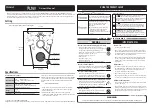
CT33 User Manual v. X1.0 10
7.
Using the receiver and probes
7.1
Choosing right frequency and probe for each task
CL43 receiver supports 512Hz, 10kHz and 33kHz frequencies so it is suitable for various tracing tasks:
Frequency
Probe
Intended use
Operating distance
33kHz
SA43
Cable & wire tracing with the CTT33 transmitter
Locating 33kHz duct sondes (Vesala MPL4-33, MPL6-33, MPL7-33, MPL9-33, PL18-33)
30cm ... 10m
≤ 10m
33kHz
LA43
Cable & wire tracing and identification at close range with the CTT33 transmitter
≤ 30cm
33kHz
KA43
Wire tracing and identification with the CTT33 transmitter
≤ 20cm
10kHz
SA43
Cable & wire tracing with some of Vesala 10kHz transmitters
Locating 10kHz duct sondes (Vesala MPL6-10, MPL7-10, MPL9-10, PL18-10)
30cm ... 10m
≤ 5 m
10kHz
LA43
Cable & wire tracing and identification at close range with Vesala 10kHz transmitters
≤ 30cm
10kHz
KA43
Wire tracing and identification with Vesala 10kHz transmitters
≤ 10cm
512Hz
SA05
Locating 512Hz duct sondes (Vesala PL18-05, PL42-05)
≤ 13 m
With CTT33 transmitter always use 33kHz receiving frequency with CL43 receiver and either black SA43 rod probe,
black LA43 close range probe or red KA43 probe. Green SA05 rod probe is only for locating 512Hz duct sondes.
7.2 Setting receiver gain
To adjust CL43 receiving sensitivity, or gain, press
(+)
or
(-)
buttons briefly. Depending on the attached probe, there
are 5 or 7 gain steps available. A beep sound indicates change of gain, no beep means that maximum or minimum
has been reached. It is recommendable to use gain which makes the LED arc length to be approx. in the middle; that
way changes in signal strength are easiest to notice. Audio signal volume and tone pitch from the speaker follow the
received signal strength.












































